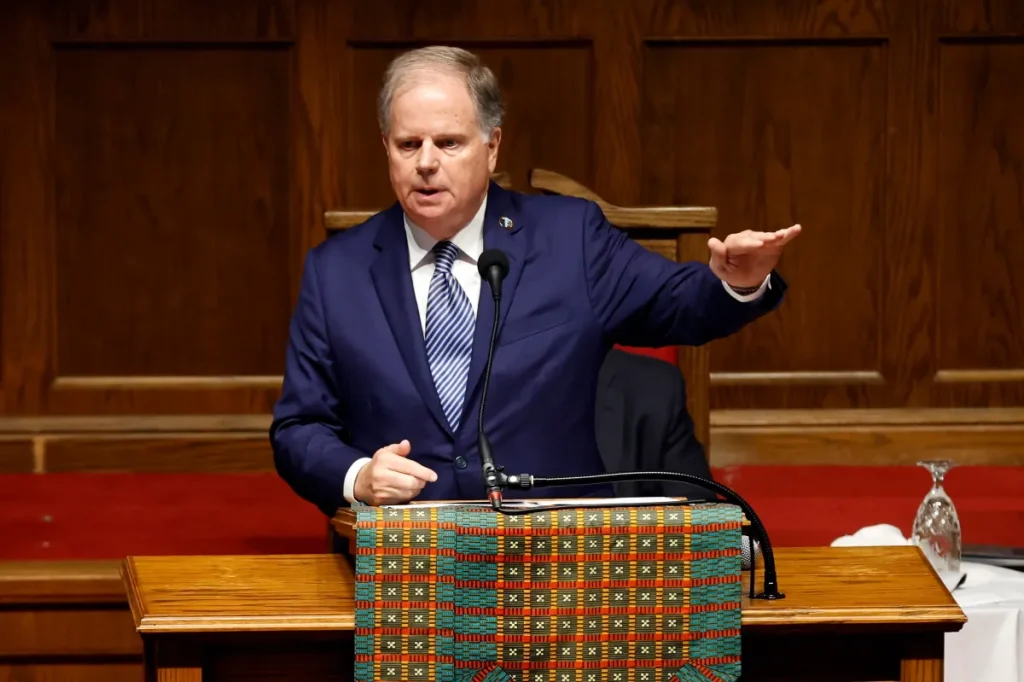Alabama’s Gubernatorial Race Shows Shifting Dynamics Despite Continued Republican Dominance
In Alabama’s upcoming gubernatorial race, Democratic politician Doug Jones faces an uphill battle against Republican Tommy Tuberville, but recent polling suggests a noteworthy shift in the state’s political landscape. According to Cygnal polling, Tuberville maintains a substantial 19-point lead over Jones, projected to win 53 percent of the vote compared to Jones’ 34 percent. While this advantage clearly favors the Republican candidate, it represents a significant narrowing of the gap compared to the 2022 election when Republican Governor Kay Ivey defeated her Democratic challenger Yolanda Flowers by a staggering 38 points. This halving of the Republican lead, despite Alabama’s solid red state status, has raised eyebrows among political observers who wonder if the GOP’s grip on the state might be gradually loosening, even as they remain firmly in control.
The political context of Alabama makes Jones’ challenge particularly daunting. The state has consistently voted Republican in presidential elections since 1980 and hasn’t elected a Democratic governor in over two decades, with the last Democratic victory occurring in 1999. This deep-rooted Republican loyalty creates a formidable barrier for any Democratic candidate. Adding to the complexity is the candidates’ history – Tuberville, who has served as Alabama’s senior U.S. senator since 2021, previously unseated Jones from his Senate position in 2020. This rematch carries personal and political weight, with Tuberville having already demonstrated his ability to defeat Jones in a statewide election. Despite these challenges, Jones’ decision to enter the race suggests he believes there’s an opening, however narrow, to make this contest more competitive than recent gubernatorial elections have been.
The polling data reveals interesting nuances in Alabama’s electoral dynamics. While Tuberville’s projected 19-point lead is substantial, it would actually mirror the same margin of victory as Governor Ivey’s 2018 win against Democratic challenger Walt Maddox, who secured 40.4 percent to Ivey’s 59.6 percent. This suggests a possible return to the slightly more competitive environment of 2018 rather than the overwhelming Republican dominance seen in 2022. The Cygnal poll, conducted in mid-November with 605 likely Alabama voters, came just before reports of Jones officially entering the race, meaning voter sentiment could shift as the campaign develops and Jones increases his visibility. With a margin of error of +/- 3.96 percent, the poll provides a snapshot of current attitudes but leaves room for movement as the campaign unfolds over the coming months.
Public statements from both camps reflect the contrasting perspectives on Jones’ chances. Jones himself has maintained an air of anticipation, responding to questions about his gubernatorial ambitions at a November town hall in Birmingham with a cryptic “Stay tuned.” This measured response suggests strategic calculation rather than impulsive decision-making. In contrast, Alabama Republican Representative Dale Strong dismissed Jones’ candidacy in blunter terms during a radio appearance, saying Jones is “begging for punishment, trying to relive past history” and confidently predicting Tuberville’s victory. These divergent tones highlight the fundamental narrative tension of the race: Republicans projecting inevitable victory versus Democrats sensing potential for a more competitive contest than outsiders might expect in deep-red Alabama.
The significance of this race extends beyond Alabama’s borders, potentially offering insights into broader national political trends. While Alabama remains firmly Republican territory, the narrowing margin could signal subtle shifts in voter sentiment that might manifest more dramatically in swing states. For Republicans, maintaining their dominance in traditional strongholds like Alabama is crucial to their national strategy, making any erosion of their support—even if victory remains likely—a cause for concern. For Democrats, making inroads in seemingly impenetrable red states represents a key component of their long-term strategy to rebuild influence in the South. Jones’ previous success in winning a Senate seat, albeit under unusual circumstances following allegations against his Republican opponent Roy Moore, demonstrates that Democratic victories in Alabama aren’t impossible, just highly improbable.
Looking ahead, the race will develop through several key milestones before voters make their final decision. Primary elections are scheduled for May 2026, with the general election following in November of that year, giving both candidates extensive time to refine their messages and build campaign infrastructure. Tuberville’s May 2024 announcement of his gubernatorial bid gives him a head start in organizing his campaign, while Jones’ more recent entry means he’ll need to quickly mobilize supporters and donors. The extended timeline also creates space for unforeseen developments that could alter the race’s dynamics. While Tuberville maintains a commanding lead and Alabama’s Republican voting history strongly favors his candidacy, the narrowing margins suggested by current polling indicate that this race may reveal evolving political currents in a state long considered a Republican fortress—even if those currents aren’t yet strong enough to change the expected outcome.


